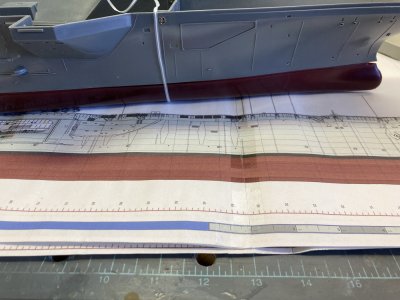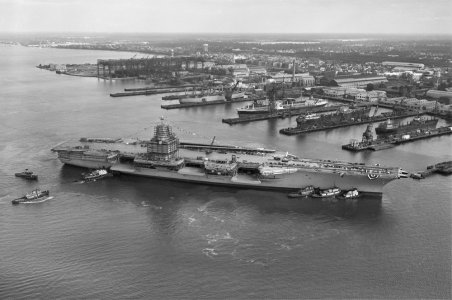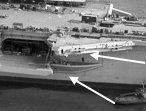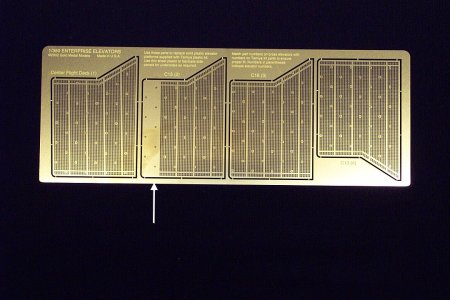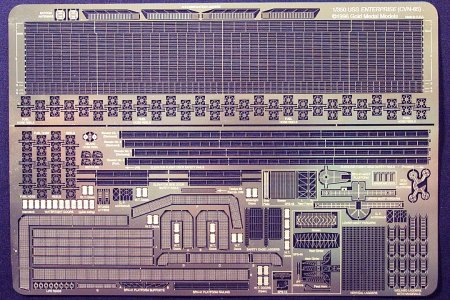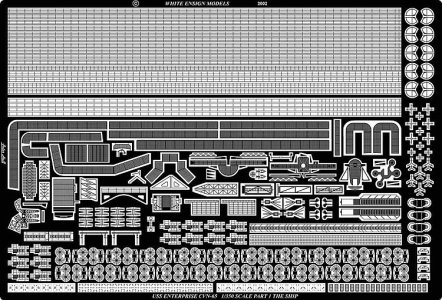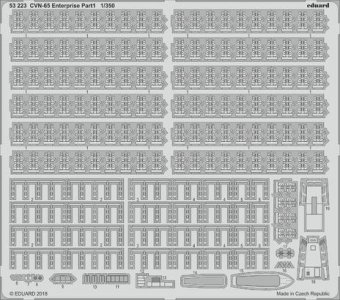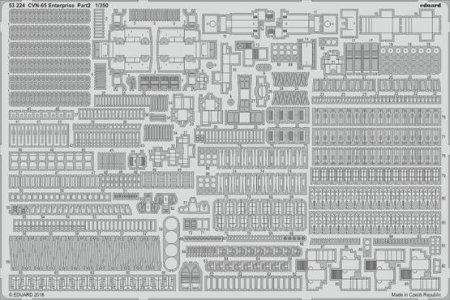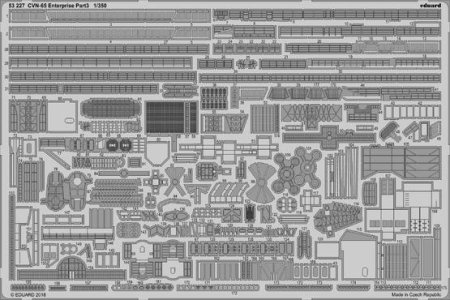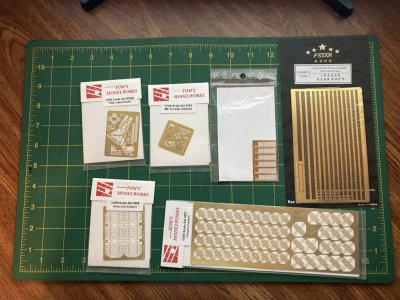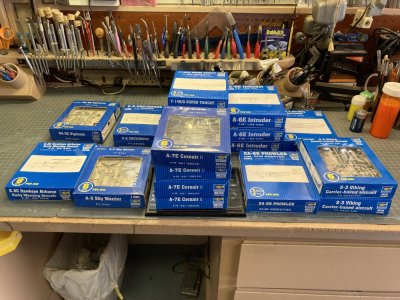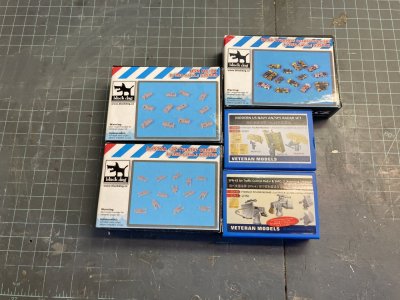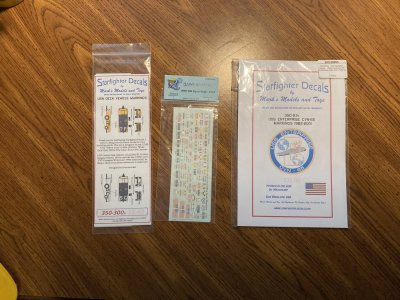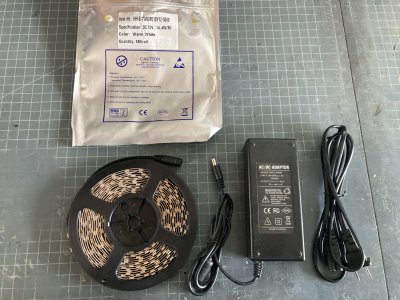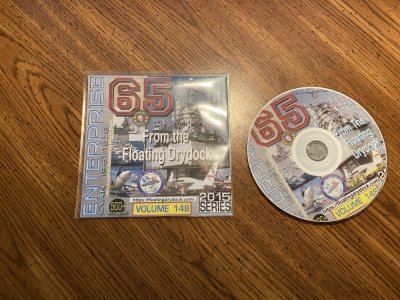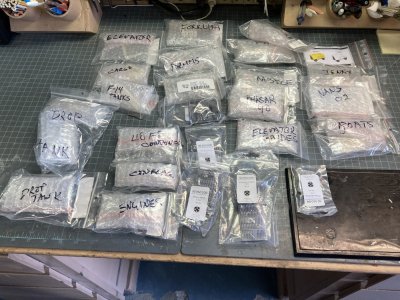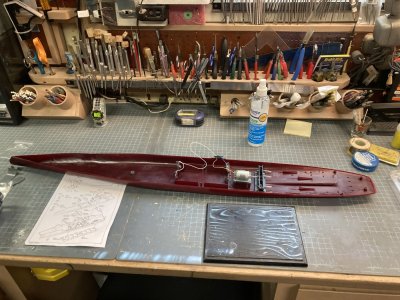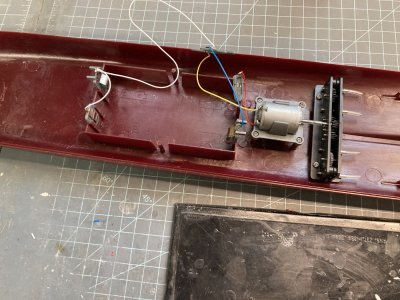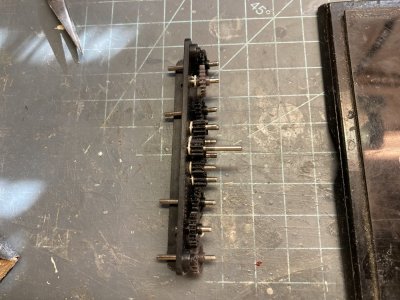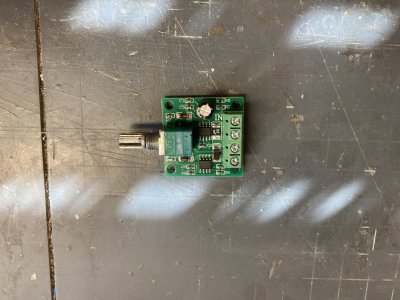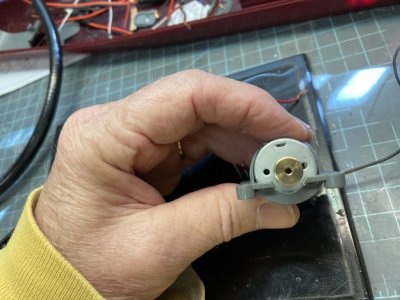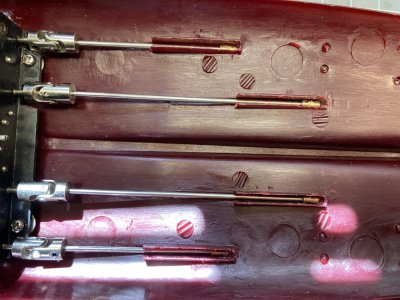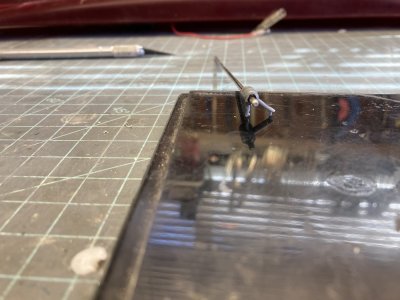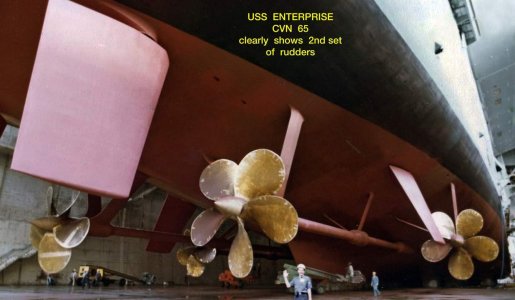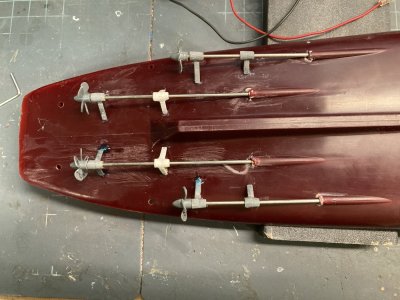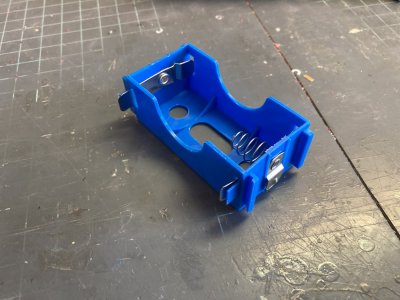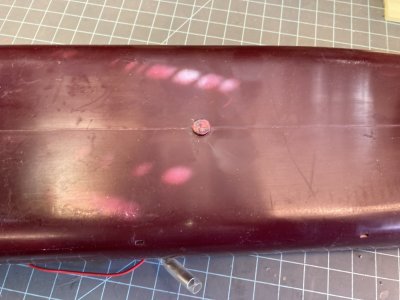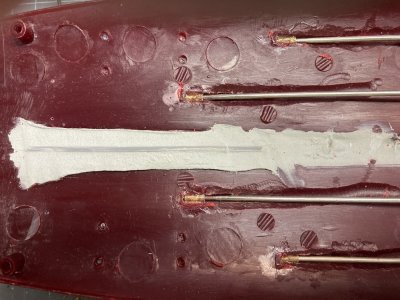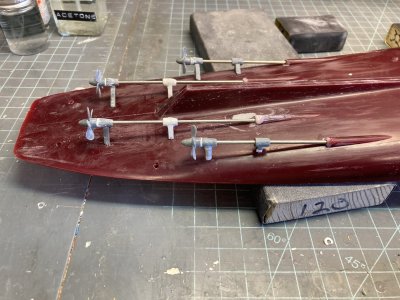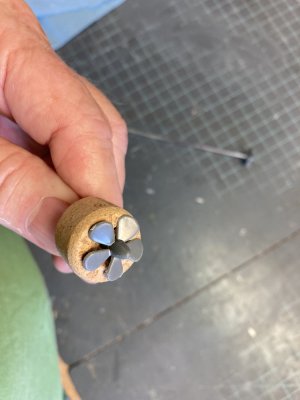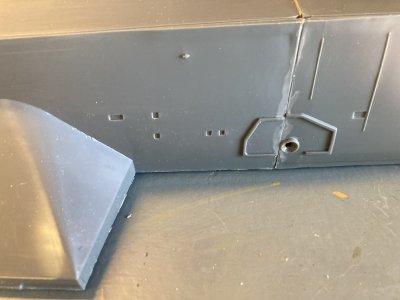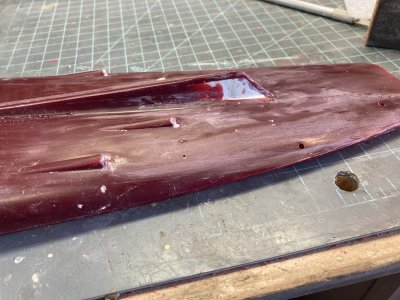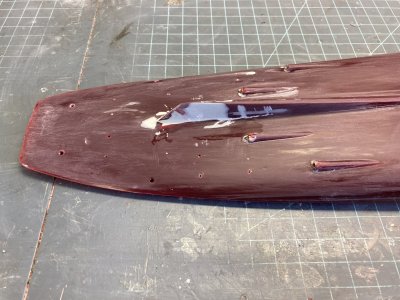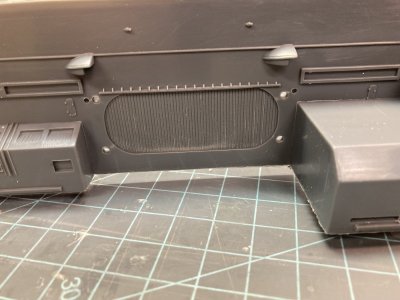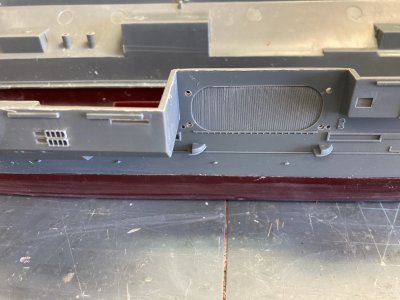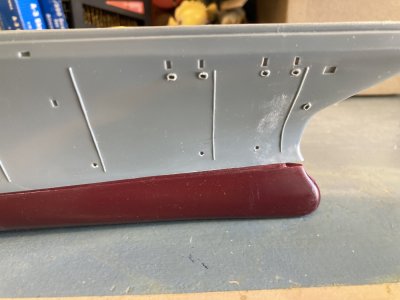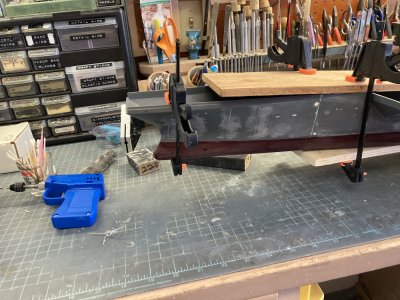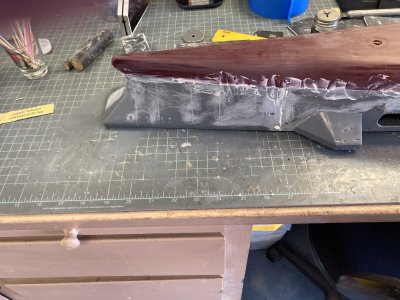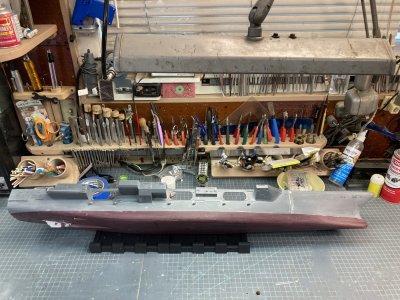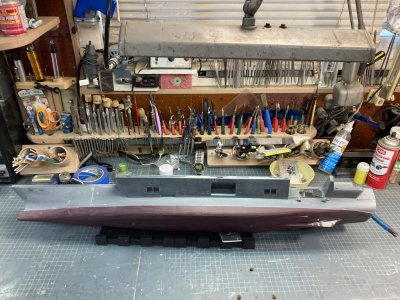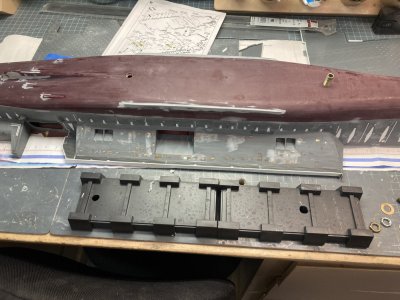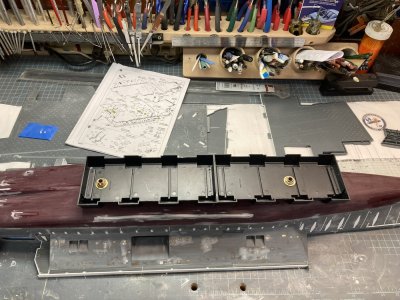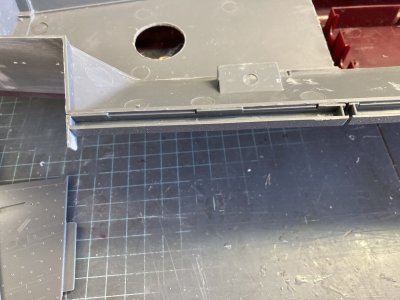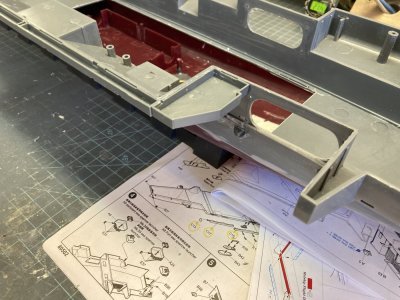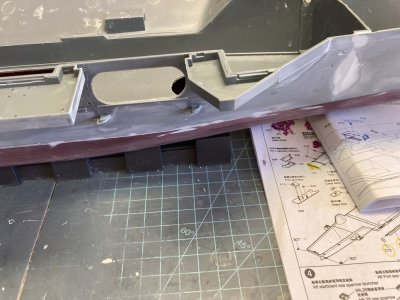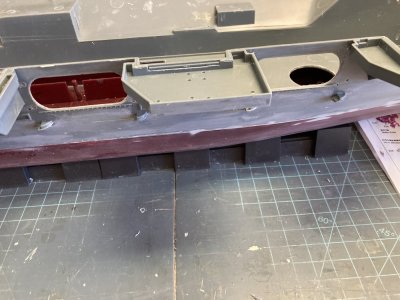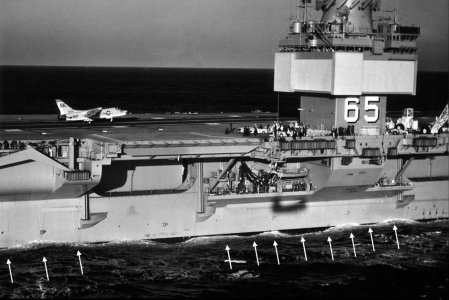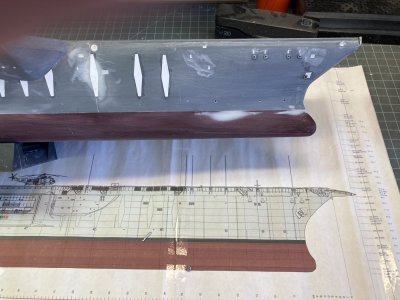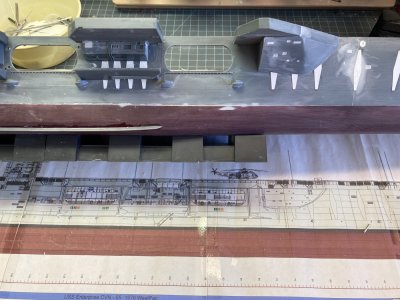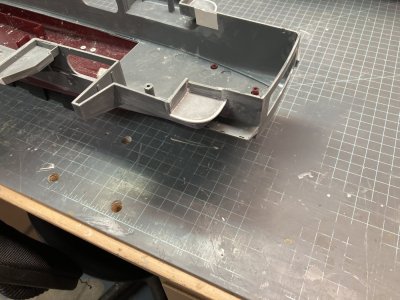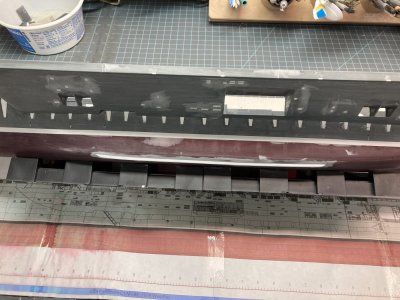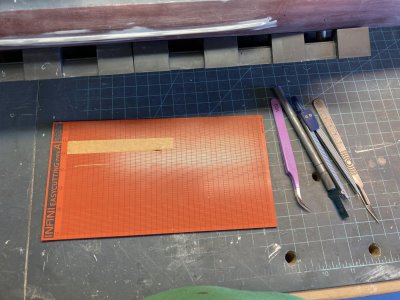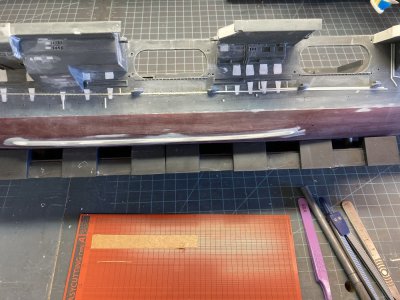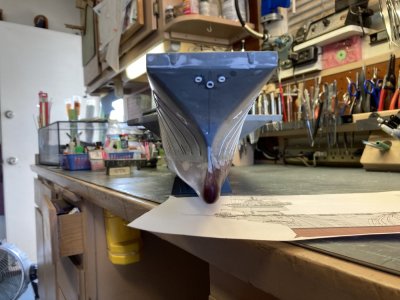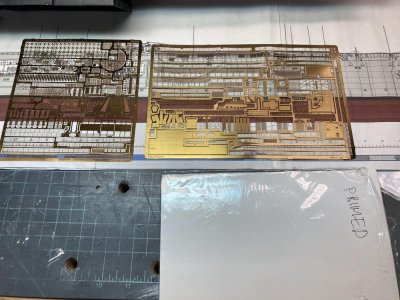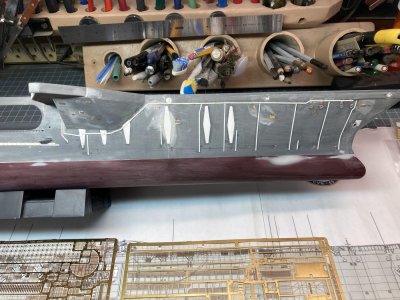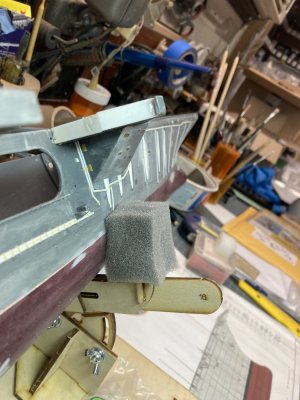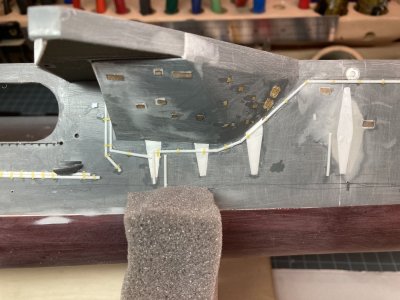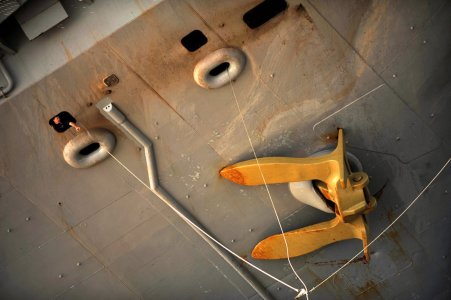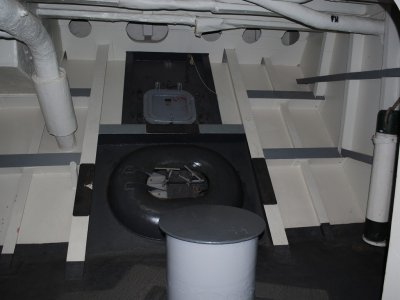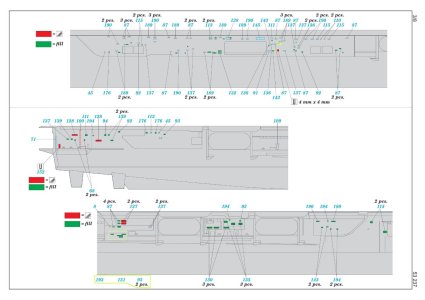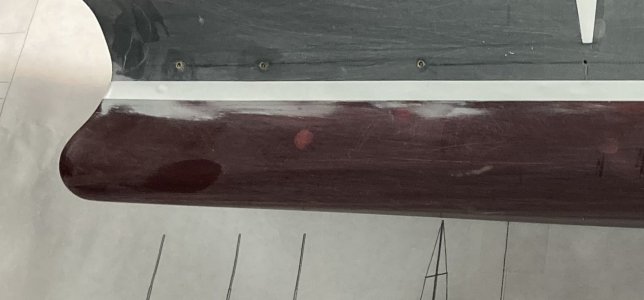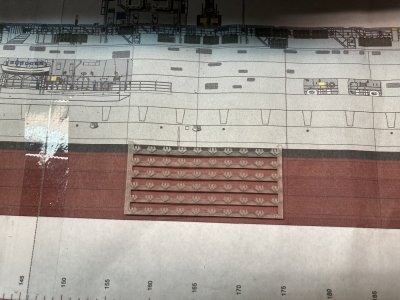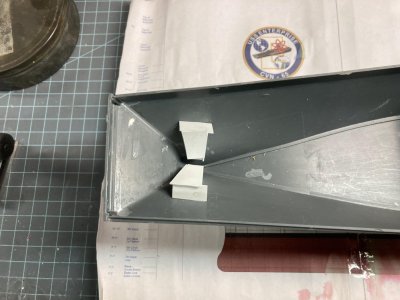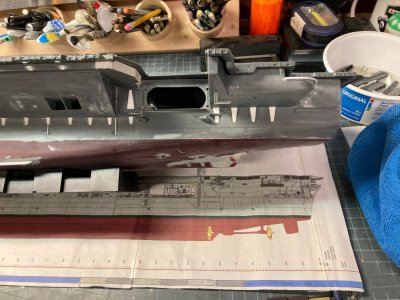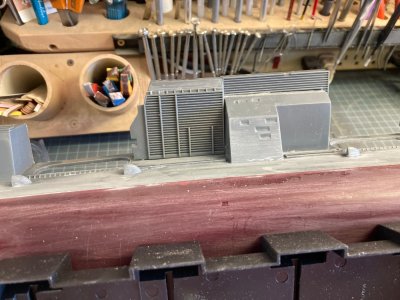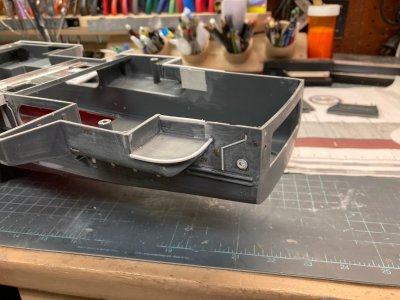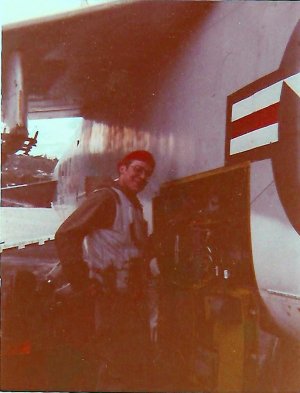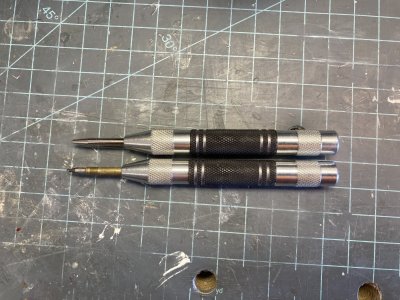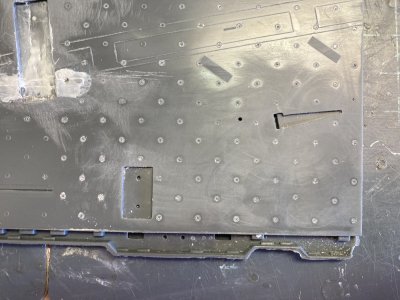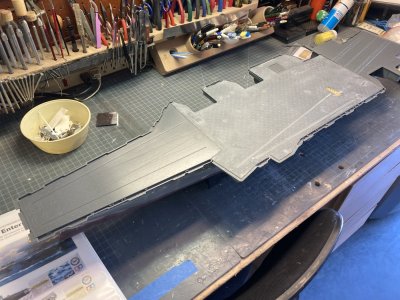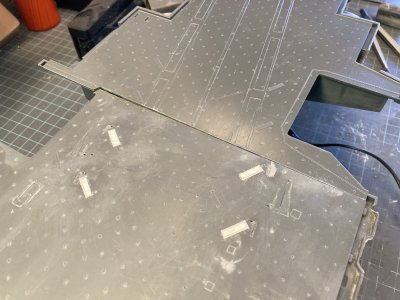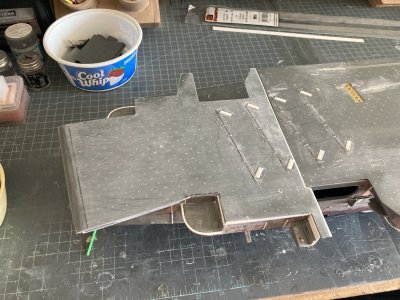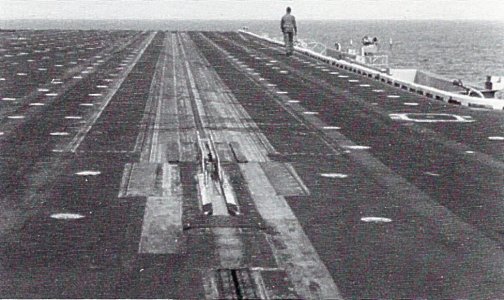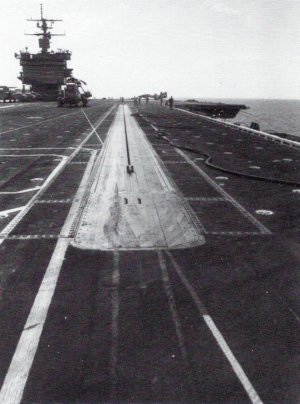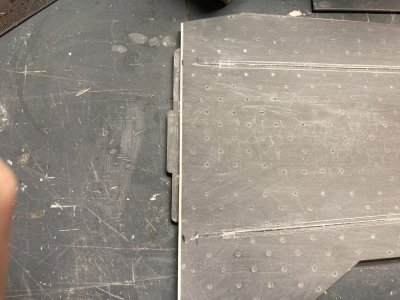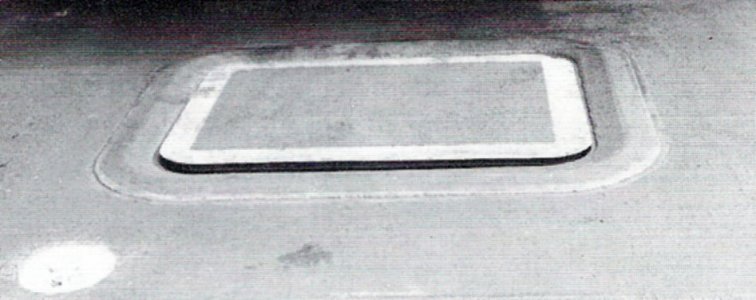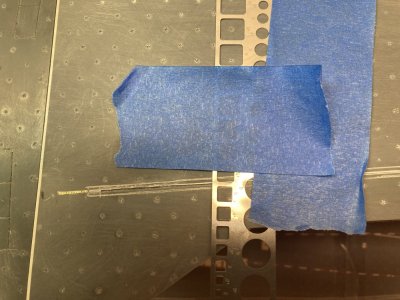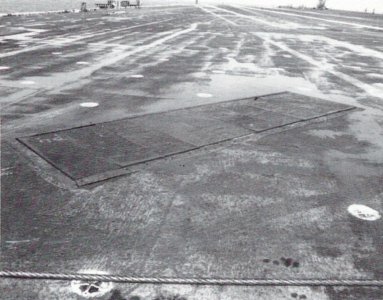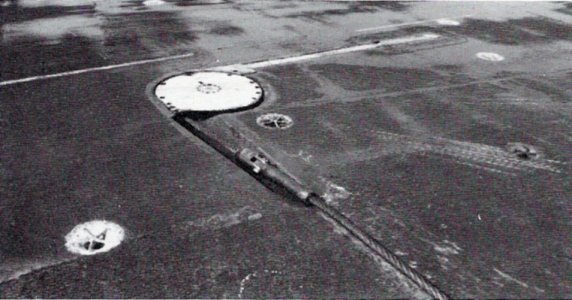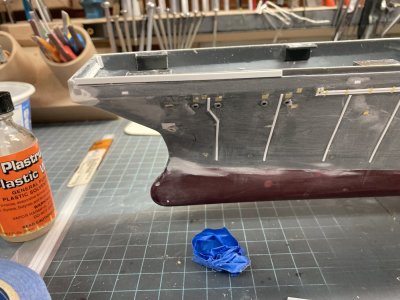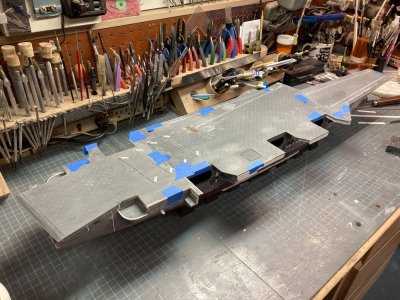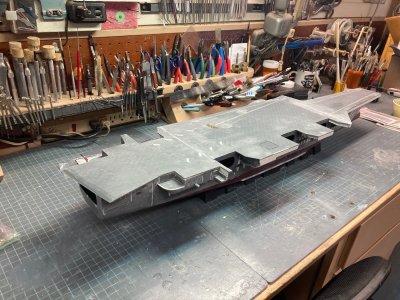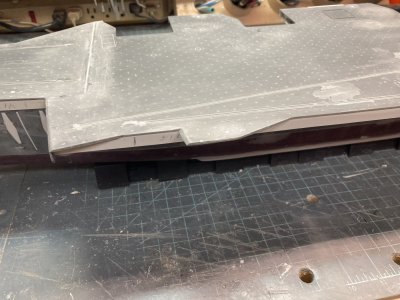- Joined
- May 8, 2021
- Messages
- 53
- Points
- 78


The kit on my workbench
Part 1
The first USS Enterprise was a 70 ton sloop armed with 4 twelve pound cannon captured from the British in 1775 on Lake Champlain. She was burned in 1777 to prevent recapture. The second Enterprise was a originally a private 8 gun schooner built in Maryland that served on Chesapeake Bay and around Maryland during the same time. The third Enterprise was a 135 ton, 85 foot schooner armed with 6 twelve pounders. She served with the Navy from 1799 to 1823 when she ran aground and was lost. During her career she fought in the undeclared war with France from 1799 to 1801 and in the Mediterranean during the Barbary Coast Pirate Wars. She was rebuilt and up gunned to 16 twelve pounders fighting in the war of 1812 when she captured the British brig Boxer. The fourth Enterprise was a schooner of 194 tons armed with ten guns built at the New York Navy Yard. She entered service in 1831 and served in the Atlantic, Pacific and the East India Station. She was sold in 1845. The fifth Enterprise was a wooden steam powered Corvette displacing 1375 tons and was nearly 200 feet long. She was armed with 10 guns and crewed by 184 men. She operated in the Atlantic, Mediterranean and the West Indies. She would become a training ship and was sold in 1909. The sixth Enterprise was a private yacht converted to a Motor Patrol Boat for service in World War I. She was purchased in 1916 and sold in 1919.
The first six ships named Enterprise served proudly but the seventh, CV-6 made a memorable name for herself during WWII. She was built in the late 1930’s at the Newport
 Shipbuilding and Dry Dock Company. The keel was laid in July, 1934 and she was launched on October 3, 1936. She was commissioned in 1938 and was the second ship of the Yorktown class, 1 of 3 purpose built aircraft carriers. The Navy’s first. Of the three, only Enterprise would survive WW II. At one point she was the only aircraft carrier in the Pacific. She was the first vessel to sink an enemy combat ship, the submarine I-70. She fought in every major battle in the Pacific and was the most decorated ship in US Naval History receiving 19 battle stars. She was the only ship to receive both the Presidential and Navy Unit Citations. The Japanese called her the Blue Ghost after reporting sinking her several times. Of all the ships built during the war she truly deserved to be set aside as a monument or museum. Tragically she was sold for scrap in 1958 despite the efforts to preserve her. Six portholes from the bridge of CV-6 were removed and used on the Captain’s cabin on CVAN-65. These are to be moved to CVN-80 which will next bear the name of Enterprise.
Shipbuilding and Dry Dock Company. The keel was laid in July, 1934 and she was launched on October 3, 1936. She was commissioned in 1938 and was the second ship of the Yorktown class, 1 of 3 purpose built aircraft carriers. The Navy’s first. Of the three, only Enterprise would survive WW II. At one point she was the only aircraft carrier in the Pacific. She was the first vessel to sink an enemy combat ship, the submarine I-70. She fought in every major battle in the Pacific and was the most decorated ship in US Naval History receiving 19 battle stars. She was the only ship to receive both the Presidential and Navy Unit Citations. The Japanese called her the Blue Ghost after reporting sinking her several times. Of all the ships built during the war she truly deserved to be set aside as a monument or museum. Tragically she was sold for scrap in 1958 despite the efforts to preserve her. Six portholes from the bridge of CV-6 were removed and used on the Captain’s cabin on CVAN-65. These are to be moved to CVN-80 which will next bear the name of Enterprise.The keel of USS Enterprise CVAN-65 was also laid down at Newport
 Shipbuilding and Dry Dock Company on February 4, 1958. She was launched on September 24, 1960 and was commissioned into the US Navy on November 25, 1961. She first put to sea as a commissioned vessel in January of 1962. In 1975 she was re-designated as a CVN and would remain so for the rest of her service. In 2012 she would complete her final deployment, decommission and be consigned for scrapping. During that 51 year period she would deploy overseas 25 times. After her first overseas deployment she returned to homeport only to put to sea again for the Cuban Missile Crisis. She made 6 combat deployments to Vietnam between 1965 and 1972. During the 1975 deployment she participated in the evacuation of Saigon. Over the course of the War on Terrorism she participated in every major action except Desert Shield/Storm because of a yard period. She served on the East coast, moved to the West coast and returned to the East. 23 Captains commanded her. Over the course of her career she was awarded 19 medals and ribbons, many awarded multiple times. She was the first nuclear powered aircraft carrier and the 8th ship of the U.S. Navy to bear the name Enterprise.
Shipbuilding and Dry Dock Company on February 4, 1958. She was launched on September 24, 1960 and was commissioned into the US Navy on November 25, 1961. She first put to sea as a commissioned vessel in January of 1962. In 1975 she was re-designated as a CVN and would remain so for the rest of her service. In 2012 she would complete her final deployment, decommission and be consigned for scrapping. During that 51 year period she would deploy overseas 25 times. After her first overseas deployment she returned to homeport only to put to sea again for the Cuban Missile Crisis. She made 6 combat deployments to Vietnam between 1965 and 1972. During the 1975 deployment she participated in the evacuation of Saigon. Over the course of the War on Terrorism she participated in every major action except Desert Shield/Storm because of a yard period. She served on the East coast, moved to the West coast and returned to the East. 23 Captains commanded her. Over the course of her career she was awarded 19 medals and ribbons, many awarded multiple times. She was the first nuclear powered aircraft carrier and the 8th ship of the U.S. Navy to bear the name Enterprise.CVAN-65 was 1,123 feet long overall, 1,040 feet at the waterline. Her maximum width is 257 feet with a beam of 133 feet at the waterline. From her keel to the top of the mast she was 269 feet in her 1978 configuration. She was so tall that the UHF mast extension was designed to fold over to get under the Golden Gate and Bay Bridges. She displaced 90,000 tons fully loaded. Various armament configurations were tried over her career but because of budget limitations Enterprise was armed with only her air wing for defense as launched. She went down in history as the first nuclear powered aircraft carrier.
In February, 1958 I was not quite 3 years old. The keel laying made no impression on me. I might have heard her name on the news a time or two as I grew up. In 1969 I watched the news reports in horror while she burned. In 1972 I was in my junior year of high school, a C & D student. A level of scholarship attained more from not trying than any fault of the school, curriculum or the teachers. I had no interest in going to college and generally disliked school. I’d had a part time job since I was 13 so I had no aversion to work just the classroom. I spent most of my free time building model airplanes and day dreaming about flying. When I wasn’t doing that I was riding or working on my motorcycle. I never took the SAT or the ACT college placement tests, I barely did homework. In December of 1972 the draft lottery was held and I watched it with my best friend. This lottery was for men born in 1955 who would be of age (18) in 1973 (Me). They drew my birthday early, I believe as number 44! It turned out that this would be the last year of the draft. The1973 lottery was held but never filled. The All Volunteer Military arrived a year too late for me. My friend was destined for college. Knowing that there was no deferment in my future, I decided to make the rounds of the Armed Forces Recruiters. Better to enlist and get some choice was my thinking at the time. I went with the Navy.
The Navy recruiter in my hometown of Findlay, Ohio was a Chief Aviation Electronics Technician named Don La Favour (I hope I spelled that right Don). He was primarily in patrol aircraft. He had served as aircrew and he was matter of fact, and I felt, honest. After testing me he said that I could virtually ask for any enlisted program and get it. Apparently I had learned something after all. He offered me a six year active duty nuclear power program and then a similar advanced avionics program. I only wanted to serve the minimum and then get out. I told him that all I wanted to do was work on airplanes. He seemed to understand that. I had worn glasses since the fourth grade, so I thought that I probably wouldn’t qualify for any flight program. Working on planes was better than nothing. (I could have gone aircrew after all but when I was rated an Aviation Fire Control Technician there were no flying billets available for my rate.) Chief La Favour was able to guarantee a school seat in 1 of 4 aviation electronics ratings providing I could pass the schools, AT, Aviation Electronics Technician AQ, Aviation Fire Control Technician, AX, Aviation Antisubmarine Warfare Technician or TD, Tradevman or more correctly Training Device Man (More school yay!) So I enlisted in the Navy for a standard 4 year enlistment. (4 years active and 2 more in the reserves, the least amount I could serve for and still get my guaranteed school seat.
He also got me a delayed entry which let me enjoy a final summer vacation with my friends. On September 22, 1973 I arrived at Great Lakes Naval Training Center at 0200 as a Seaman Recruit and began a 22 year career with the Navy. I surely did not know that I would stay that long at the time. I got my draft call-up in October while still in boot camp. They do start out “Greetings…” I took the letter to my Company Commander and asked him what I should do. His answer was to have me drop and give him 50, He said, “The draft can’t have your a_ _ because your a_ _ belongs to the Navy!” By the end of boot camp I knew that I did not want to be a TD because they were virtually on permanent shore duty and they worked on trainers not aircraft. So of course I was designated a TD out of Boot Camp.
From December of 1973 to June of 1975 I went to various Navy Schools. For a guy that hated school it seemed endless. But it was an eye opener too seeing how math and physics all worked together to become electronics and it all slowly was made clear and even interesting to me. The Navy also provided a little better motivational tools than the public schools did, at least in my case. Pass or get stuck in some s_ _ _ job. While I was attending Avionics “A” School I happened to ask if there was a way to change rates during class. Turns out one of my classmates who was designated an AQ, wanted to be a TD because it was his father’s rate. By virtue of a pair of Special Request Chits, the Navy’s version of you can ask for anything and maybe you’ll get it forms, we were able to exchange positions.
In 1974 or 75 the Navy began airing a new batch of television recruiting commercials while I neared the end of my schooling. One of them stands out to this day, Drum roll, “Dawn, the South China Sea, flight deck of the USS Enterprise. You are there.” Some scenes of aircraft on the flight deck and it finished up with “Join the Navy it’s not just a job, it’s an adventure!” I was on my way.
In February of 1975 I reported to NAS Lemoore, California for training at VA 122 (Attack Squadron or ATKRON 122) (again more school). I arrived obligated for 6 years of active duty as a Third Class Petty officer. Something I signed up for while in Tennessee. But this time I was learning my trade and it was a hands-on type of school. I would be part of the Integrated Weapons Team (IWT) for the LTV (Ling, Tempco, Vought) A-7E Corsair II. I learned about the RADAR, Inertial Navigation System, the Tactical Computer, Weapons Delivery, Heads Up Display and a plethora of other equipment. It was actual work on the airplane. While there, two of my classmates and I were told to be prepared to travel immediately overseas. This was during the evacuation of Saigon. We remained on standby for a couple of weeks. In the end we finished our school normally. In June of 1975 I finally checked aboard VA-27. My first fleet unit, the “Royal Maces, were assigned to CVW-14 (Carrier Air Wing 14) which deployed aboard the aircraft carrier USS Enterprise! In January of 1976 the Air Wing went aboard Enterprise for the first time in the deployment cycle as she began REFTRA, (Refresher Training,) this was my first time at sea.
I spent a total of six years with VA-27, two back-to-back sea tours. I made two sets of work-ups and two full deployments to the Western Pacific and Indian Ocean, (WESTPAC/IO) aboard the “Big E” and another deployment aboard the USS Coral Sea CV-43. It turns out that I was good at electronic repair and troubleshooting. I liked what I was doing and so I had stumbled into a job that was my niche in the world, it caught my interest. I became a part of something bigger than just me, a valued member of a team. I found that working on jets on the flight deck was an adventure all right. I saw the world. I saw a bunch of water horizon to horizon too. The stars at night are something to behold at sea. I have a good collection of “Sea Stories that I love to trot out upon meeting (drinking) with other old salts. Most have some element of truth to them. Not long after I left VA-27 I was advanced to First Class Petty Officer.

Enterprise outward bound from Alameda in 1978
I wanted a model of my first ship as she looked during the 1978 deployment with a full air wing, a time rich in memories for me. This was the ship’s final deployment with the beehive island and my second. I originally set out to build the 1/400 scale Aurora/Monogram/Revell, (A/M/R) kit of the Big E. (They even sold the Aurora version in the Enterprise ship’s store.) In 1992 a friend gave me his Aurora kit which he had started on. Later I found a Monogram version with a more modern air wing and I obtained one Arii aircraft set. I started on it in 2006 this was almost 20 years after I got the Aurora kit. I got a good way into building up a hanger bay for that kit. I had several errors corrected too.
As I labored over the hanger bay I kept finding new photos of the ship almost as soon as I scratch built a part which then required a rework of what I had just done. I quit trying to proceed on memory for everything. I made a good set of drawings to pin down details after scouring the internet for photos. The drawings were based on the 1/400 scale model. First I drew the hanger bay and then the exterior and finally some of the aircraft. I still fiddle with those drawings making corrections. Despite my best efforts I was unable to get any more aircraft sets. The only available one was the Otaki/Arii aircraft set which while not great had all the right types of planes except for the EA-3B Skywarriors. Shapeways sold several aircraft in that scale, but they were expensive and not all that good for the money. I could not find more of the Arii sets or if I did the seller wanted a prohibitive amount of money. With everything I had it wasn’t even half of the full air wing.
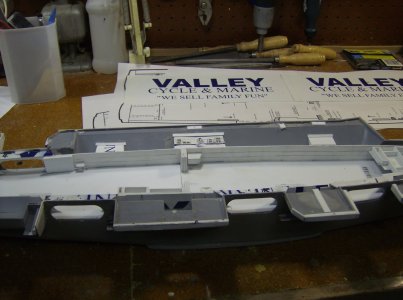
Work in progress on the hanger on the Monogram kit. I worked in a motorcycle shop at the time the and some of the plastic came from license plate inserts that I kept when the store changed it's name.
There were very few aftermarket parts available in 1/400 scale. There wasn’t even a purpose made set of photoetch. I learned how to make my own photoetch starting with the grated elevators. But this is very messy and labor intensive. Because of that and a warped and twisted hull that wouldn’t stay straight, (despite boiling water and clamping to a flat surface). I finally relegated it to the shelf of doom. I purchased the Arii kit of the early Enterprise but while it has better detail than the Monogram version, disappointingly it isn’t as accurate dimensionally. So I decided to get a 1/350 scale model having seen the Tamiya kit built up in many online posts and magazine articles. It looked very good although most of the builder’s spoke of errors they didn’t specify exactly what. There are a bunch of aftermarket items including additional aircraft in 1/350 scale. You can even buy a 3D printed hanger bay if you can afford it.
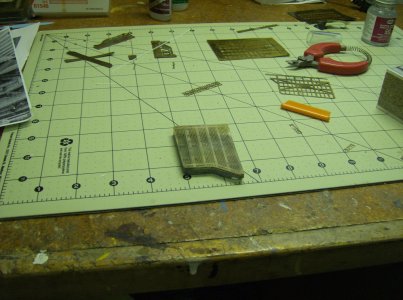
Elevator 4 from the Monogram kit with my photoetch grate.
Tamiya released their kit of the USS Enterprise CVN-65 in1984. Trumpeter produced what most sources say was a copy of the Tamiya kit in the 1990’s and then in 2001, Mini Hobby got the molds and brought out two versions of the kit, number 80501, Modern and 80502, Early. I found a source in China on eBay and purchased an “Early” version and waited nearly 6 months to get it because of the COVID pandemic. The early version turned out to be the same as the modern with the exception of 2 parts to represent the early beehive island. And those are not accurate. All the sponsons for the modern version are also present on the early version kit, CIWS mounts, MK-29 missile launchers, life raft canisters, antennas and the mast are in both kits. None of which is correct for the ship before 1980. There aren’t any alternate parts trees to truly represent the early version. The one advantage of the Mini Hobby kits is that they are significantly cheaper than the Tamiya. Mine was less than $50.00 and no shipping.
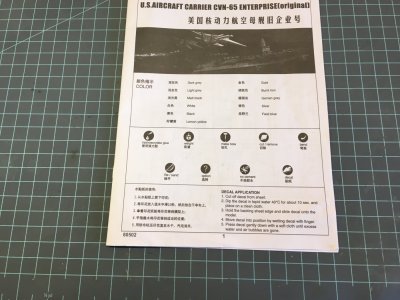
The instruction booklet
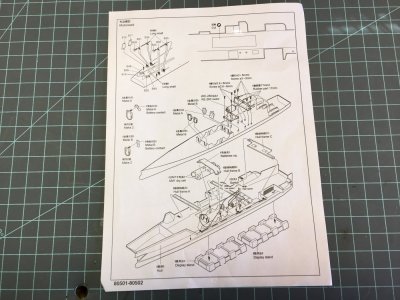
The motorization addendum

The parts in the box

Motor, battery box, transmission, metal parts and stand
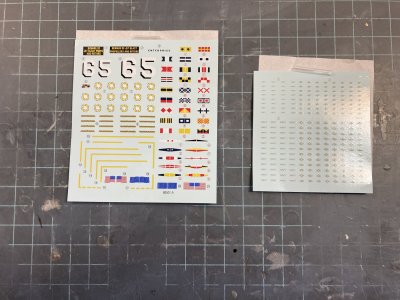
The decal sheets the color is a bit too blue and the deck hatch decals should be a white center surrounded by a red and yellow band. The Tamiya sheet is the same but the blue color is more correct.

Sprue A

Sprue B
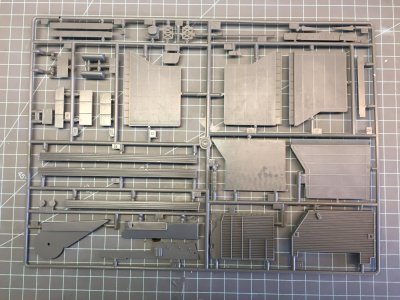
Sprue C
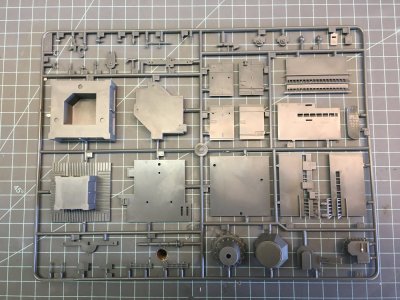
Sprue D. Note the beehive parts, those are the only things in the kit to represent the early version of the Enterprise.

Sprue E (X 2)

Sprue P (X 8) If you compare this to the Tamiya aircraft set number 1 you will see they are the same.
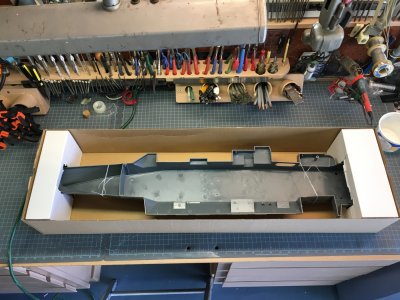
The Hull in the box (note that it is fitted together)
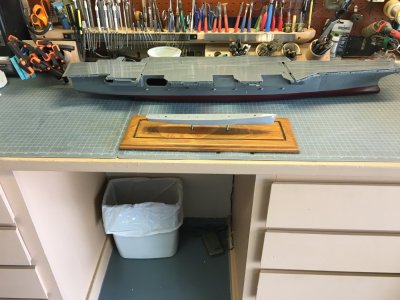
Hull and flight deck components compared to the 1/350 scale Fletcher class destroyer
In the box you will find 6 sprues of ship parts, 8 of aircraft, 3 sections of flight deck, a 3 piece hull which is fitted and screwed together but not glued up, 2 sections of stand, a bag of motorization parts and some metal braces and screws. There is a small sheet of decals for the ship and another for the aircraft. Essentially the same stuff with minor differences compared to the Tamiya kit. There is a 20 page, 7 3/8 x 10 ¼) black and white instruction booklet and an additional addendum sheet showing assembly of the motorization components. I watched a You Tube series by Ken Chee Kum , (Modelar)and he says that these motors are often in Mini Hobby Kits. Watching his build brought out a lot of the issues I would face. He used the Eduard photo etch in his build. I find that watching others building models to be very helpful. You can pick up great techniques and have a better idea of the pitfalls. The ship parts are in medium grey plastic except the lower hull which is appropriately in red, while the aircraft are light grey and the stand is black. The sprues are all bagged but not separately, 2 or more are bagged together. And all the aircraft are in one bag. The model is boxed in a sturdy cardboard tray but this is annoyingly slid into an end opening cardboard box. As soon as I started working on the model I modified the box so it could be opened from the top.
My first impression was this is the Tamiya kit. But the detail is on the soft side. None of the sponsons have the cut outs for the elevator supports to pass through. The A/M/R version has these. The upper hull is the same as Tamiya’s in the front and back sections but then it is further divided at the waterline. The Mini Hobby box is long enough to hold the full hull so they could have made the hull without the separate bow especially since the waterline section is a single piece. The flight deck is broken into 3 sections so you can access the batteries in the hull after you motorize it. I vaguely remember the Tamiya kit could be motorized also when it was first released. The beehive island part was reported to be oval rather than round in a review I read, but measuring with a digital caliper shows the parts to be the same in X - Y dimensions. The upper beehive should have 6 rows of Alford T type receiving dipole antennas. Four rows are exposed, some 240 little T’s. Thankfully the upper 2 rows were so fragile they were encased in a protective tube. The kit does not have anything to represent these. Their flight deck breaks down the same way as the Tamiya kit’s, even the metal brackets are similar. The switch for the motor would stick up through the flight deck midsection though! I can’t find any indication of this in any Tamiya builds. The decals for the ship appear to be too light in the blue areas.
I had picked up a Tamiya instruction booklet and a decal sheet from eBay and compared the two kits based on instruction guides. The sprues are lettered the same but they are not laid out identically. The part numbers are not the same. The Tamiya kit appears to have elevator 1 molded with the flight deck and you add the support structure to the underside. The remaining 3 are assembled from 3 parts. All the Mini Hobby elevators are molded separately, but only elevator 1 has a separate underside support structure. The remaining elevators assemble from 2 parts. The aircraft sprues will allow you to build 40 aircraft total but there will be 8 A-7E and 8 F/A-18A or C aircraft. No air wing included both types it was one or the other. Like the Tamiya kit there are no E-2B/C, SH-3D/H or EA-6B’s. Tamiya does make a second aircraft set to cover these planes and also adds F-4C Phantoms. F-4’s were replaced in most air wings by the F-14A’s again one or the other type. F-14’s couldn’t fly from Midway Class or earlier carriers.
I had purchased a set of scale drawings from the Floating Dry Dock in 1/192 scale while working on the Monogram model which were reduced to 1/400 and upped later to 1/350 scale. These were useful in getting my drawings right. The owner helped me a great deal with this he is a modeler as well as an entrepreneur. The plans are from his G series which is made up from USN Booklets of General Plans. These appear to be builder’s proposal drawings not the final product. Curiously the island has Pri-Fly (Primary Flight Control) on the same level as the Navigation Bridge a mistake also present on the A/M/R model. It was always on the level above the Navigation Bridge. Also drawn is a sponson forward of elevator 1 at the hanger deck level which was present on the just launched ship but then later was removed. I could not find any information about this. I do have a photo. The drawings matched the Monogram kit almost exactly but they were off for the Tamiya Kit (and the Arii.) The waterline dimensions were almost right on the money, but the length and width of the flight deck is too big. Maximum width of the flight deck, including catwalks is 257 ft. according to Bert Kinzey’s book. In 1/350 scale that would be 8.811 Inches. Mini Hobby’s measures 9.375 (9 3/8) inches at the widest point, 273 scale feet. The length is a bit long by about .25 inch. The three starboard elevators are out of position by .25 inch too far aft each. I believe these dimensional faults are present on the Tamiya kit also. I do not have any plans to fix these problems. I wasn’t willing to cut up the Arii model to fix similar errors either. The corrections would require a massive amount of work. Tape it all up and it looks like the Enterprise.

One of the many drawings I made this is the 1st deck drawing of the hanger bay
The larger flight deck should make it easier to place the whole air wing aboard. The real ship had problems with this for many years especially with the “Grumman Air Wings” of 70’s and 80’s. I intend to build the kit full hull but there is an error with the lower hull that I am thinking about correcting. The keel extends down the centerline aft and comes to a wide blunt end. This is wrong it should end in a tapered blade like shape. The Tamiya and Arii model also have the same problem. I’m not sure why this is wrong on so many kits. The A/M/R hull was more correct. With the full hull on display the error will be visible. Probably no one looking at it would know the difference but the full hull would look more graceful corrected. I do intend to add a full hanger bay. I purchased sheets large enough to cut out the whole thing from Evergreen Plastic.
Last edited:





